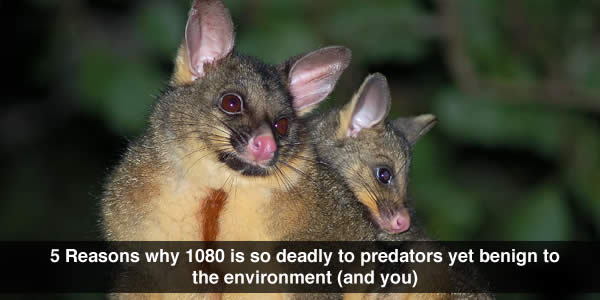1080 has been in the press a lot lately – with Auckland Council voting to use it in the Hunua Ranges (a major source of water for Auckland City) and the new Minister of Conservation, Maggie Barry endorsing its use. New science has even ruled it safe to eat trout after a 1080 drop. But why exactly is 1080 so deadly to predators and yet so benign for the environment?
There are a number of reasons, and it has a lot to do with New Zealand’s unique natural history.
1. 1080 is a natural substance that targets mammals
1080 is actually the same substance used by plants that are trying to put off mammals from grazing their leaves. For example, it naturally occurs in black tea leaves (grown in India and Sri Lanka)! As a result it has a more potent impact on mammals than it does on other animals. Luckily, all of the introduced predators in New Zealand are mammals – possums, rats and stoats. The cereal bait is designed for rats and possums, but 1080 drops also knock down numbers of mammal predators such as stoats and feral cats because they eat the carcasses of the rats and possums.
Of course the downside of targeting mammals can be when dogs or cattle escape and wander into a 1080 drop zone. Dogs in particular are susceptible, which is why it is important to keep your dog on its lead when walking in these areas.
2. 1080 is less potent for our native birds, insects, eels and fish
Thanks to our natural history, New Zealand has very few native mammals – only our native bats fit this class. As discussed above, 1080 is far more deadly to mammals than it is to other animals, such as birds, insects, eels and fish. In other words our native birds, insects, fish and eels need to eat a lot more of the stuff than a mammal does to get a fatal dose.
Bait design also helps; dying them dark green and flavouring them with cinnamon attracts rats and possums but puts off most birds. As a result, native bird deaths – either from eating the bait or poisoned carcasses – are rare. Individual deaths do happen; however native bird populations survive and flourish after 1080 drops. That is because their chances of surviving and breeding are better with fewer mammal predators around.
3. 1080 dilutes and breaks down quickly
Another advantage of using a natural pesticide is that our bodies can break it down very quickly. So if we eat or drink a little, our bodies can process it. Only when the dose reaches critical levels does it cause our bodies any harm.
1080 is soluble in water, which has raised a lot of concern in the past. However, it dilutes and breaks down quickly in the environment, which is why it is even safe to drop in an area used for Auckland’s water supply. As Forest and Bird advocacy manager Kevin Hackwell pointed out recently, the Ministry of Health guideline for 1080 in water is less than the amount you would get from a cup of tea.
4. 1080 does not accumulate in the food chain
Because it breaks down quickly, 1080 does not accumulate in the food chain. This means that there is no risk of it building up in our bodies and causing a fatal dose over time.
The one downside of this is that possums and rats can get sick from eating a poisoned pellet, but not die. This makes them ‘bait shy’ – they remember the bait made them ill so they avoid it in the future – an effect that can last up to three years in possums. This is why 1080 is not used to eradicate predators, only to control them.
To counter this, poison drops usually kick off with ‘pre-baiting’ – where they dump a lot of non-poisoned bait first to get the rats and possums in the habit of munching it.
5. 1080 is registered for aerial application
At an average cost of $17 per hectare, aerial application is cheaper than sending people out to set traps and bait stations on foot. This means that our money can be used to control predators over a bigger area of forest, and ends up saving more native birds.

